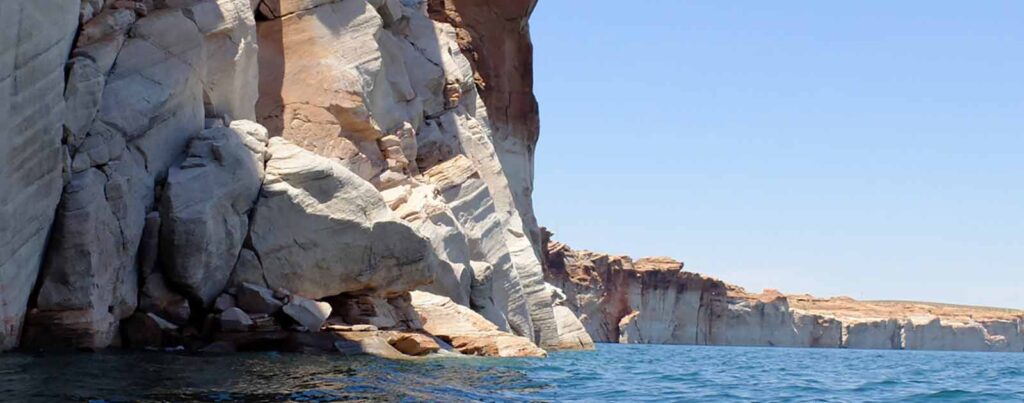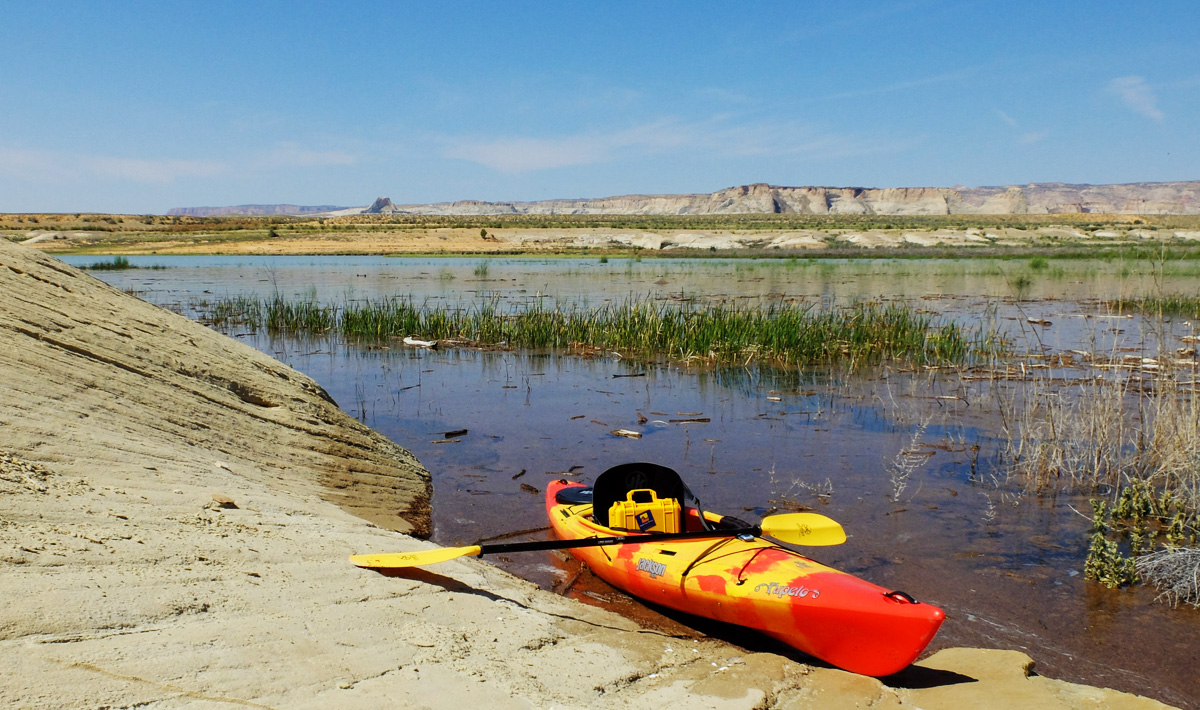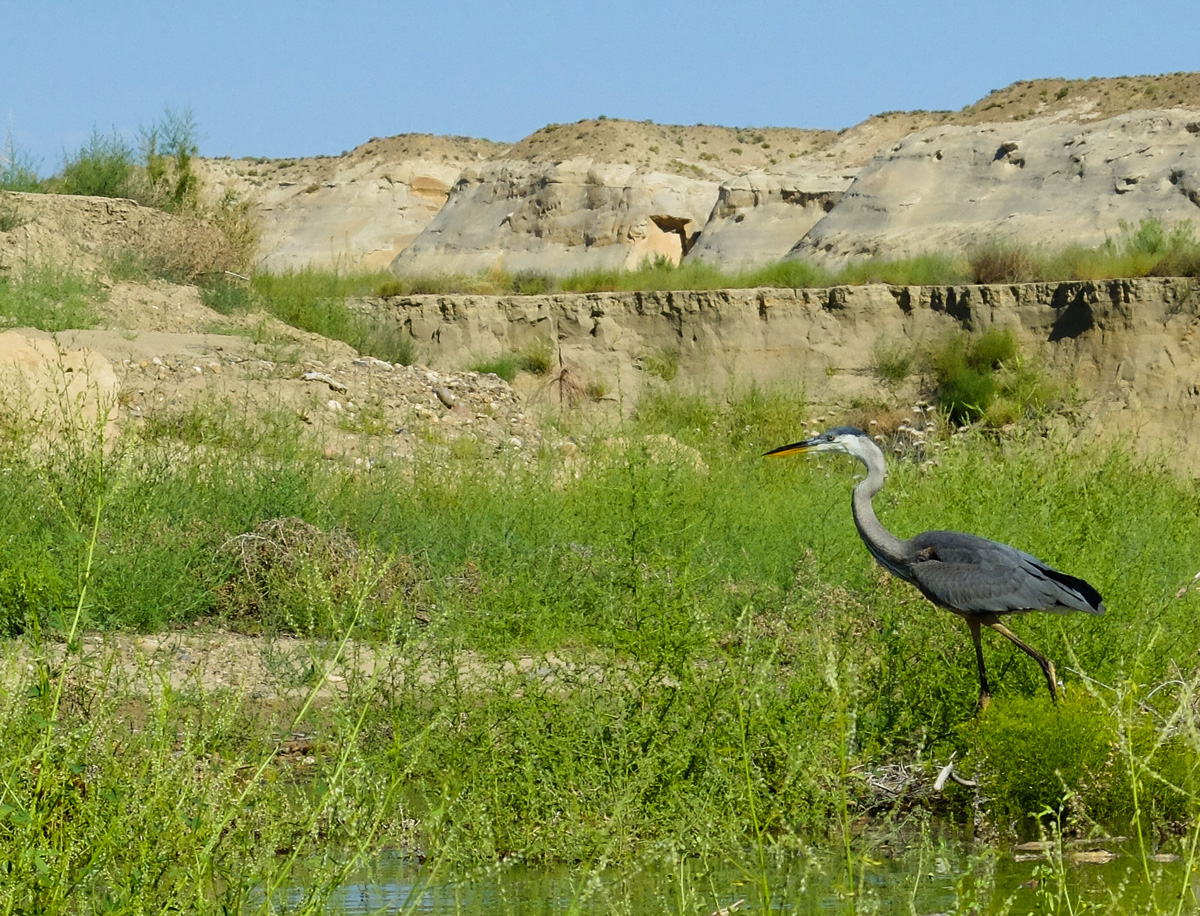
Sweat is draining down from under my sun hat, drenching my shirt – and I’m not even working! Simply bobbing along in my bright orange sea kayak, out on a massive, man-made reservoir in the middle of June is enough to wick the hydration straight out of my cells.
I had come west from the cool mountains of Colorado to this place, Wahweep Marina on Lake Powell in northern Arizona, with a New York-based film crew to make a short piece on the drought, overuse of the Colorado River, and what solutions might be possible to put water back into this river and work towards a sustainable future in the southwest. We have a pair of kayaks, a half-dozen cameras and booms and gimbals and even a small drone to illustrate what the levels in this lake, and the heat, are telling us all across this arid region.
Just days earlier, Lake Mead, the other giant reservoir 280 miles downstream that, together with Powell, bookends the Grand Canyon, had reached a critically symbolic and important milestone – it’s elevation had dropped to below 1,075 feet – the level at which, if it were to remain at or fall even further by the beginning of 2016, the US Bureau of Reclamation would be forced to perform an in-depth analysis of the future of water supply in the southwest. This could result in dramatic cutbacks, affecting people, agriculture, and wildlife in the region – most notably here in Arizona. These painful and drastic measures, though, may be what is required to start pulling this part of the basin back from the brink.
But this reality is already before us, whether the elevation in Lake Mead is sitting at 1,075, or 1,090, or 1,055 – the Colorado Basin is over-tapped, over-used, and stretched thin. Action must be taken now, and everyone from all walks of life in the southwest must lend a hand.
Here on Lake Powell, the situation is easy to see – the contrast painted across the towering walls between the rusty sandstone caps and the pearly-white “bathtub ring” is stark. At about 50 feet high, the mineral deposits left from the shrinking lake tell a story of overuse, of drought, and of a warming climate, that together are creating a perfect storm that must be addressed with thoughtful and sustainable solutions. Fortunately, those solutions are ready, proven, and available – we simply need the will to put those solutions in place, and sooner than later.
But first – I need a drink. Its 104 degrees out here – the sun is simply relentless and the breeze nonexistent. Like all systems, sometimes you have to put some water in to make them work right – without it they break down. Your body must conserve, be efficient, and not waste its vital hydration to stay fit and keep working, moving forward. Simply storing more won’t work if the entire system is out of alignment.
In the Colorado Basin, we know that there are a number of things that can make a world of difference. First, cities and municipalities can have a huge impact by conserving water and being more efficient. Additionally, every city and town in the basin can find ways to reuse water, whether it is supplying gray water to urban landscapes and parks or going so far as cycling that water through the municipal water supply system. Next, we need to implement ways to help agriculture become more efficient and more importantly, increasingly sustainable in the face of all the challenges that farms and ranches across the west constantly face. They grow our food and provide much of the cultural and historic spirit of the southwestern US. Lastly, we have an opportunity to move our energy consumption to more renewable sources, like solar and wind, which have significantly less demand than the water needs of cooling coal-fired or natural gas generating stations, or for the exploration of natural gas or shale. The transition to renewable energy sources is a transition that saves an abundance of water.
Living in the southwest is an honor that about 35 million people get to enjoy and prosper. From the wide-open spaces, to the clean air and an abundance of outdoor activities, to the food that is grown for an entire nation, all of us are lucky to call this region home. But with that comes a responsibility to make it work for all of us, AND the river and the people and wildlife that depend on it at the same time.
Right now, I need to get a big drink before I head back to my dock – passing out from the heat and lack of water out here is not an option.
We all enjoy the dynamic, exciting, and life-giving abundance that this river provides for us – let’s lend a hand to help give back to the river that takes such good care of us, and let’s start doing that now.







